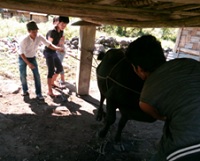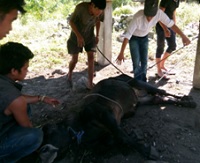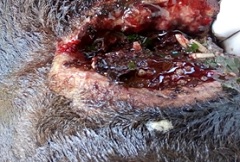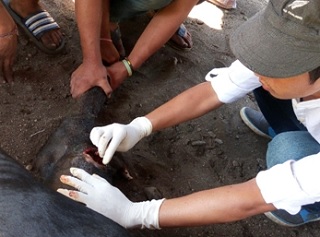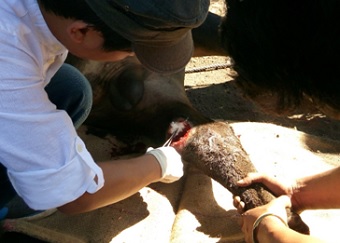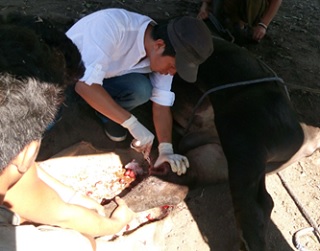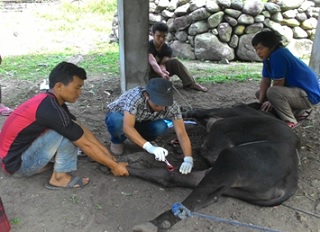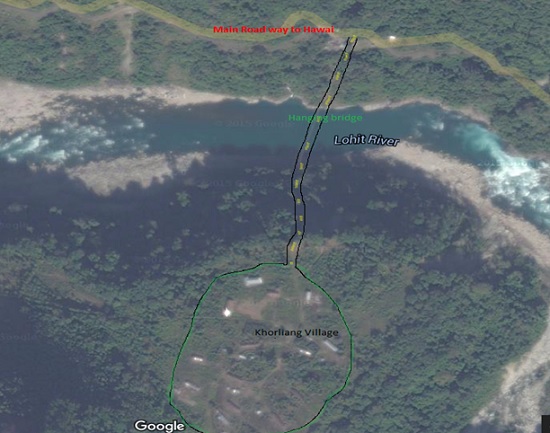A case report in cattle (Bull): Maggotic wound dressing and its management. (KVK, Anjaw Arunachal Pradesh).
A farm women from Khroilang village, Mrs kilong Mai Chiaty came with a chief complain of her bull weighing about 300 kg was injured near hock joint by sharp object while grazing in jungle. The wound was not healing due to house fly and maggot infestation, further wasp aggravate the wound by biting the piece of meat in every visit.
Khroliang village is 10 km from KVK, camp office Hayuliang and from main road to Khroliang village by foot march, it takes around 15 minutes to reach the village by crossing, Lohit River a tributaries of mighty river Brahmaputra, through hanging Bridge. Location of Khroliang village is captured through Google map (Fig. No. 8). On reaching the spot a black coloured bull was tied beneath the grain store house, with soiled and maggot wound in palmer side of hock joint.
Following procedure were followed during course of management for soiled and maggotic wound dressing.
Animal was restrained with the help of rope by “Roufs method” Animal was tied with rope in pole and another loose rope was tied in neck and same rope was passed over body by making half hitches around shoulder joint and hip joint. One man standing in front of bull hold the horn and twisting the head opposite to the direction of side of body to be expose upside and other man holding the end of rope running through the animal body making half hitches pulling simultaneously at the same time, as a result the pressure exert in weak point due to pulling of rope and twisting the head gently make animal to fall without any struggle.
Wound was tied with gauge bandage by owner to control the fly attack and bleeding. First bandage was removed and all the hair in and around wound was shaved with BP blade for easy dressing and proper healing of wound, as presence of hair near wound is predisposing factor for laying of housefly eggs and it increase the time of healing due to interruption in intention of healing mechanism.
The wound was thoroughly washed with disinfectant, a solution of 2% potash water, using absorbent cotton with the help of tissue forceps. The maggot was removed using tissue forceps as much as visible from outside. It was very difficult to remove the live maggot from inside tissue because of constant movement and anchoring in tissue, so turpentine oil using cotton was plugged in wound for overnight to kill all the live maggot for easy removal.
Injection oxytetracycline 10 ml i/m and meloxicam 10 ml i/m was given to check the secondary infection and to relive pain respectively.
On next day the cotton plugged was removed and using 2% potash solution the wound was thoroughly washed and rest of the maggot and dead cell was completely removed. Again wound was thoroughly washed with disinfectant.
Topicure ointment was applied on the visible surface of wound and topicure spray was sprayed around the wound making a circle of circumscribe area to avoid the visiting fly and wasp in wound.
- Antibiotic and pain killer injection was continued for 5 next days.
- Dressing of wound on alternated days was instructed to the owner to follow till the wound heals.
Fig 1. Roufs Method of restraining animal Fig 2. Animal restrained firmly Fig 3. Maggotic wound showing maggot
Fig 4. Cleaning hear with BP blade Fig 5. Soaking excess exudate with cotton
Fig 6. Removing Maggot Fig 7. On second day,removing maggot & dressing with disinfectant
Fig. No. 8. GPS, location of Khroilang Village, Anjaw district, Arunachal Pradesh
